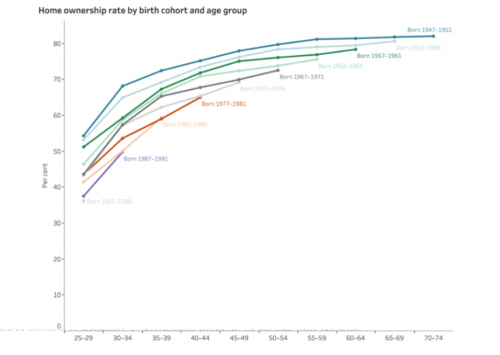

If you are one of the many young Australians trying to establish themselves in this country, perhaps through entering the housing market, building savings, or even just trying to survive, many of us find ourselves asking: was it always this hard? Surely the great Australian dream wasn’t always this difficult? A quick look at the experiences of baby boomers (those born 1946-1964) and their growing wealth lets us see that these questions aren’t unfounded.
The generational wealth divide is a term used to refer to this disparity in wealth between the older and younger generations. With younger generations inheriting the inaction of leaders, including climate change, higher public debt levels, waning productivity and geopolitical conflicts, it’s no wonder we are likely to be the first generation poorer than their parents.
One of the prime examples of this disparity, that has become both topical and well debated, is the contrasting experience of different generations in the housing market. So intense is our obsession with residential housing that the total value of our residential properties has eclipsed the $8 trillion mark– over $1 trillion more than the combined value of the ASX, superannuation, and commercial real estate and 4 times greater than our national GDP.
The Housing Market
Many baby boomers are quick to dismiss cries of millennials’ woes with housing stresses, with common responses including the 17% interest rates that existed in the late 80s, or a cleverly constructed quip about the propensity of 20-something-year-olds to buy avocado on toast. But a look into the numbers paints a clear picture that the wealth divide by generations is becoming greater and greater, and the affordability of housing now continues to slip further out of reach for the average Aussie.
In 1983, the average income was $19,188, and an average house set you back $64,039 giving a ~3.3 house-to-income ratio. Today an average house costs $896,000, with an average income coming in at $91,905 (with the median likely a better estimate due to the asymmetric nature of high earners pushing up the average), giving a house-to-income value of ~9.8. Whilst real wages have indeed risen in this period, it has failed to keep up with the seemingly perennial gains of the property market. The simple fact is that the value of houses has grown 14 times while incomes have grown just by 4.7. So next time you hear someone claiming they had double-digit servicing costs when they were young, ask them, would you rather have 17% interest rates on a $50,000 mortgage or a 5% rate on an $800,000 loan?
The pandemic didn’t help us either; Covid-19 only accelerated this disparity between generations. According to the latest Household Income and Labour Dynamics (HILDA) report, older Australians disproportionately profited off the back of rising property prices with these gains coming at the expense of priced-out millennials and Gen X’s. Alex Dunnin, Director of Research at Information services firm Rainmaker, recognised the pandemics’ negative effects but stressed “Financially it was brilliant for Boomers with a good job, a house, some super and maybe some investments,”.
Further evidence of intergenerational inequality was highlighted in the Commonwealth Bank’s recent results presentation. It showed that, unsurprisingly, younger generations have most of the debt while baby boomers have most of the savings. However, in a somewhat counterintuitive notion, younger generations have been simultaneously reducing their spending, and depleting their savings, while baby boomers have been spending more and saving more.
Another interesting consideration is the disproportionate effect of the interest rates on young Australians. One of the main mechanisms that interest rates affect spending is through mortgage repayments. With the cash rate at 4.1%, it’s important to remember that only one-third of Australia’s 10 million households have mortgages, and of these, the vast majority are aged under 45. So, younger generations are digging into their savings and cutting down on their spending in the name of fighting inflation while baby boomers are undermining these efforts, spending more, saving more, and growing their wealth.
Why does this matter?
Perhaps the disparity in generational wealth isn’t all that it’s cut out to be: baby boomers have been working for longer, have higher incomes, and have been saving. Why shouldn’t they reap the rewards of their hard work? Unfortunately, for young Australians, the situation isn’t necessarily the same. Take Figure 1 as evidence, when baby boomers were 25-29, over 55% were homeowners; now this is less than 40%. It shows an interesting dynamic, with home ownerships slipping further out of reach for each successive generation.

However, this problem isn’t unique to Australia; data from the American Federal Reserve illustrates this impact on wealth levels further. When boomers were the same age as millennials are now, they had over 22% of the nation’s wealth, compared to millennials’ 7%.
So how do we fix this?
For one, this housing-obsessed nation needs to fundamentally reassess its philosophy on housing. Efforts from the Federal Government to fast-track new dwellings go some way in lifting supply. Whilst this is a good start, the government could return to seriously committing to public housing. In the early 1940s, the Curtin government was responsible for 26% of all new dwellings built. Now, it’s a measly 2%. Perhaps if the government returned to these investment levels, it could turn the tide for aspiring homeowners, and ease the cost of living for many. The Australian dream would be one step closer for all.
Regardless, younger generations can rest easy, knowing that the reason they aren’t as rich as their parents, isn’t due to lack of hard work or dedication, but a housing-obsessed nation that has stacked the odds against them as the generational wealth gap continues to grow.
The CAINZ Digest is published by CAINZ, a student society affiliated with the Faculty of Business at the University of Melbourne. Opinions published are not necessarily those of the publishers, printers or editors. CAINZ and the University of Melbourne do not accept any responsibility for the accuracy of information contained in the publication.